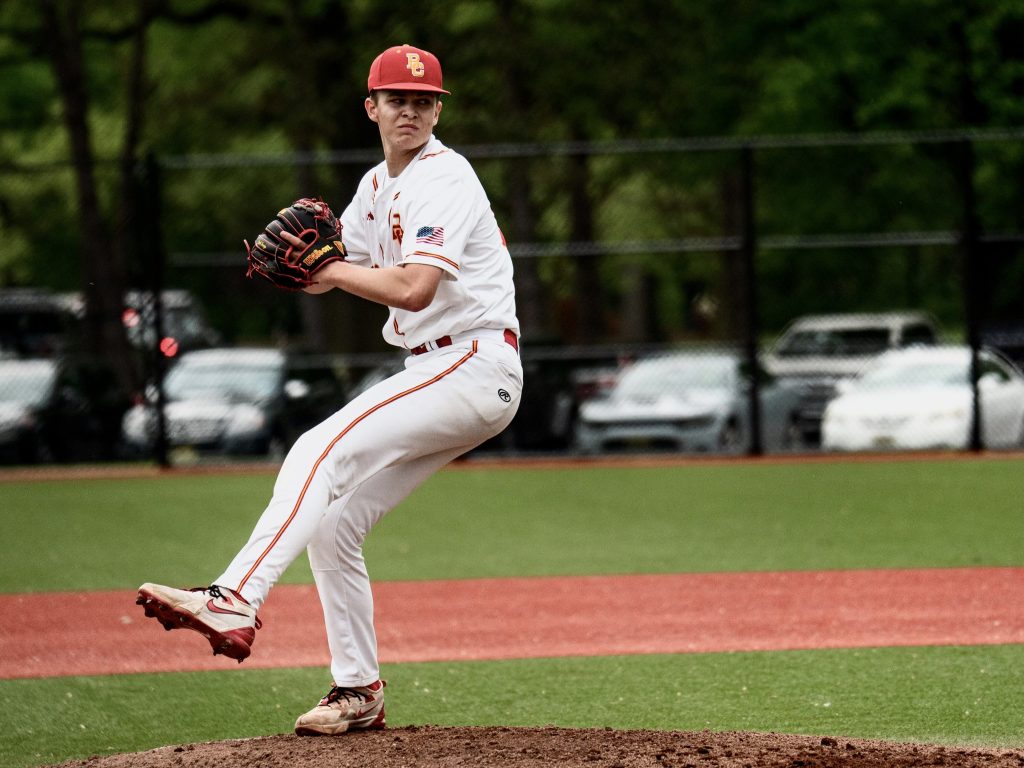
Bergen Catholic rising senior RHP Jack Pintarelli joined us last summer to get a head start on his training for spring / summer season of this year. At the time, Jack was looking to add velocity to his heater, improve his arsenal, and add lean muscle mass headed into the spring season. He continued with his training during the fall and the entire off-season. By early March (10 months), Jack had added 27 lbs. of lean muscle mass and 5-6 mph on his fastball, T 86 mph.
How did he do it?
A lot of hard work… now, let’s review in some detail.
RPP’s off-season high school programs begin in late August / early September and end in early March. Jack started the off-season with a comprehensive physical and mechanical evaluation:
1. Physical Assessment – Covers a number of important topics, including (a) lower and upper half mobility (b) lower and upper half strength (c) lower and upper half power (d) speed – 30-yard dash, (e) lower and upper half elasticity – (f) decel metrics, (g) body fat % and lean mass ratios and finally a force-velocity evaluation profile.
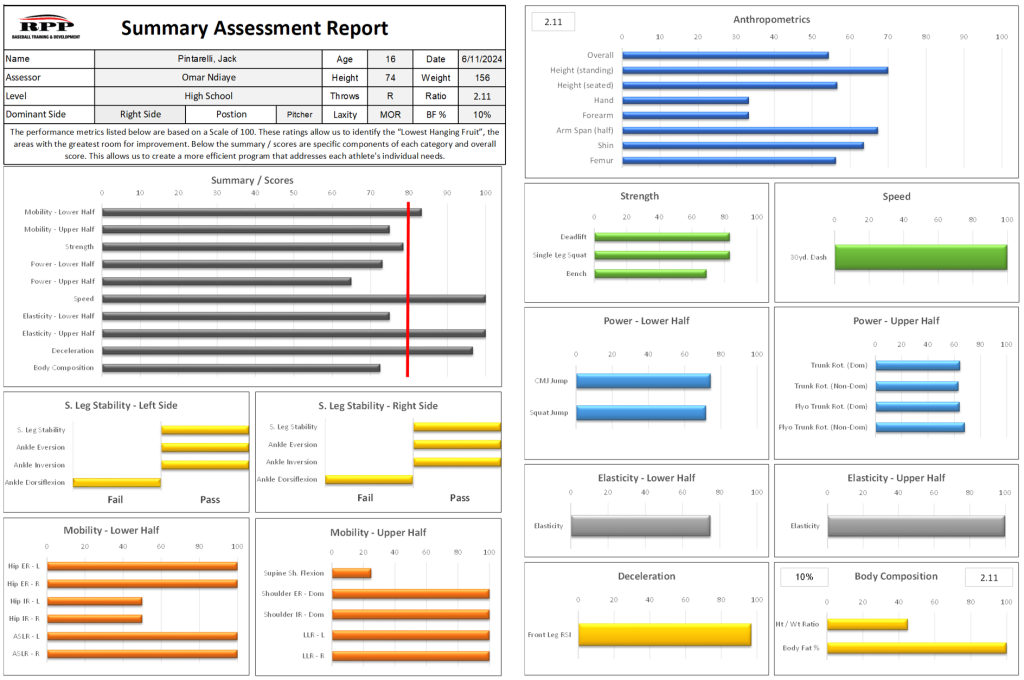
2. Mechanical Assessment – Represents a complete analysis and reporting of the athlete’s delivery and broken down into three specific areas kinematically. These include (a) arm and shoulder, (b) trunk movement and (c) the lower half.
3. Pitch Arsenal – Represents a thorough analysis of the pitcher’s arsenal, pitch-movement profile for potential improvements in movement or an expansion of the overall repertoire.
By the time an athlete has completed our evaluation, we have an excellent idea of what his strengths are and which weaknesses we should pursue to optimize performance. There is NO better blueprint. It’s the same blueprint we use during our collegiate on-site assessments.
1. Physical Assessment
Body Composition
Below is a summary of Jack’s height, weight, and body fat % from his assessment last summer. Needless to say, at 156 lbs. and 10% body fat, Jack started the program in decent physical shape, but a bit on the light side.
-
- Height – 74”
- Weight – 156 lbs.
- Ratio – 2.11 (desired rage of 2.5 – 3.0)
- Body Fat – 10%
However, the good news is that over the course of the 10-month period, Jack added 27 lbs. to his frame while maintaining his low body fat percentage.
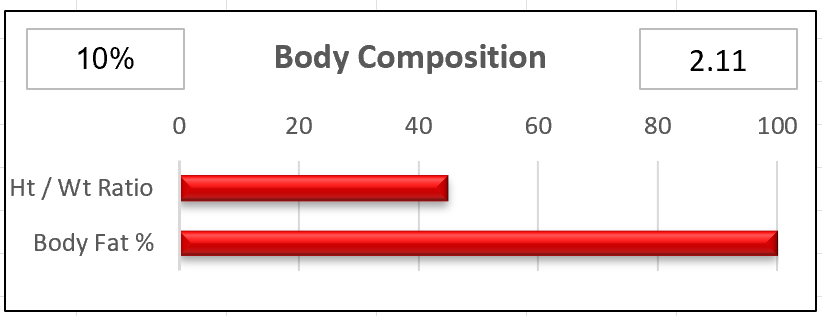
Upper and Lower Half Mobility
The movement screening portion of the assessment is essential in identifying mobility and / or stability issues that may hinder the athlete’s ability to get into optimal positions throughout the delivery. In most cases, the issues that are presented in this portion of the assessment will be visible when we are evaluating the athlete’s mechanics in the video analysis portion of the assessment.
After completing Jack’s table assessment, we found limited hip internal rotation on both hips which could compromise loading into his back hip hinge as well as effectively decelerate when rotating into his front hip through release. We also noticed that Jack had limited ROM in his lats which could negatively impact his ability to efficiently get his arm overhead and achieve better layback in his throw. Both these areas needed to be addressed.

Upper and Lower Body Strength
After completion of the movement screen, we then moved on to our strength and power testing to help give us more information about the type of athlete we were dealing with. Higher gains in these two categories help to create not only a higher velocity ceiling, but an overall more athletic body.
The following is the summary of Jack’s estimated 1RM metrics in the weight room. As you can see, Jack was underneath the sufficient strength margin for both his bilateral and unilateral strength as well as his upper half metrics on the Bench Press.
-
- Trap Bar Deadlift – 281 lbs. (vs. optimal @ 2.5x B.W.= 351 lbs.)
- Single Leg Squat – 72 lbs. (vs. optimal @ 55% B.W.= 86 lbs.)
- Bench Press – 134 lbs. (vs. optimal @ 1.25x B.W.= 195 lbs.)
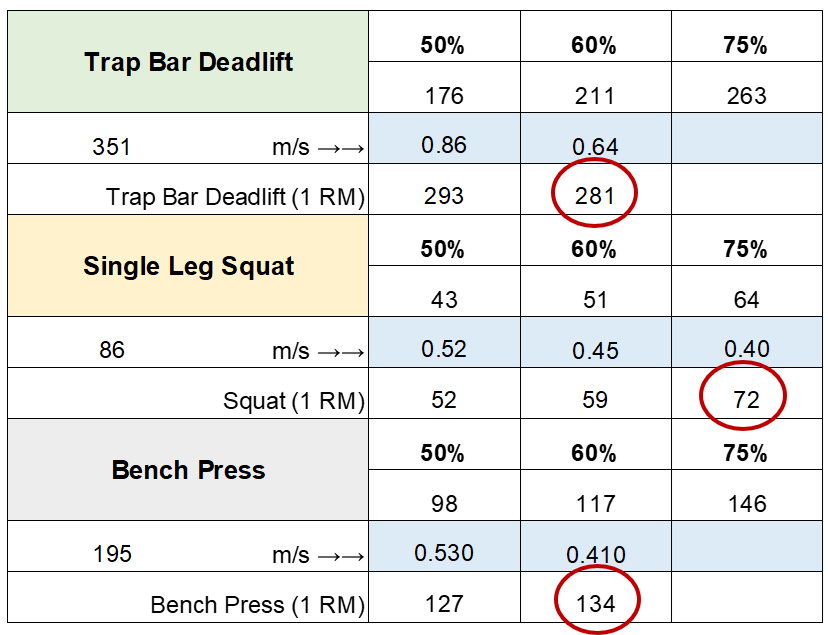
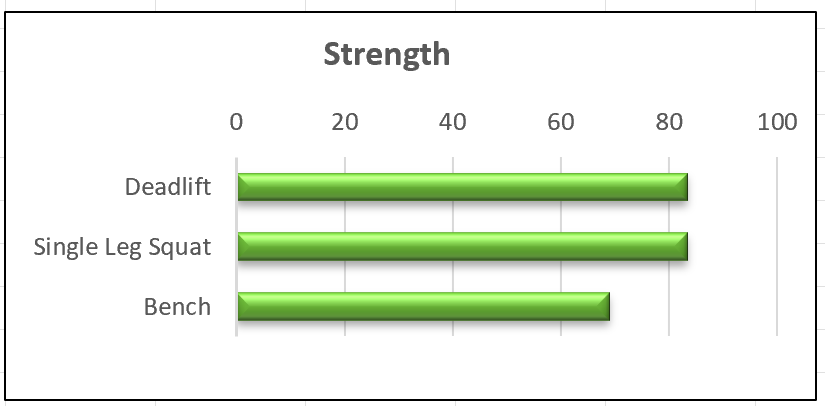
Lower and Upper Half Power
Baseball is all about how quickly we can produce Force. In other words how quickly we can produce power. Power = Force X Velocity
Lower Half – With respect to power, the first test we complete is a Counter Movement Jump (CMJ). This jump is performed to evaluate the athlete’s ability to utilize their Stretch Shortening Cycle bilaterally and relates to the velocity portion of the power equation, ultimately giving us the athletes Force-Velocity profile.
The second test, Squat Jump, is performed to evaluate the athlete’s ability to use muscular force and relates to the force side of the power equation and Force-Velocity Curve.
Jack’s lower half power testing demonstrated minimal increases in power between his more elastic CMJ jump and his strength based squat jump. So, improving his plyometric ability in his lower half would ultimately help improve overall power output.
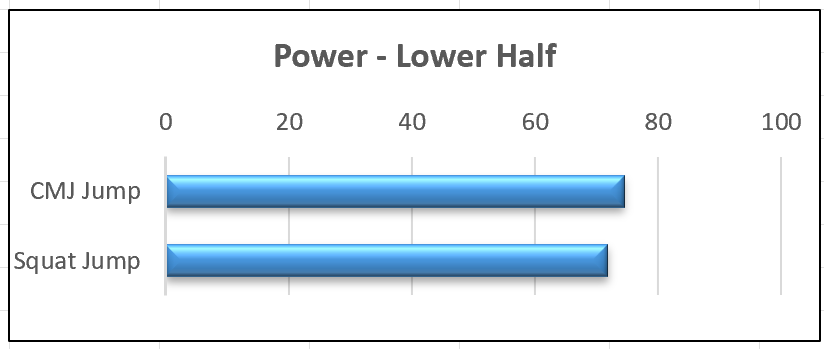
Upper Half – We test upper half rotational power on a Proteus Motion machine, utilizing two different tests:
-
-
-
- Trunk Rotation – Similar to the squat jump this involves no “pre-stretch”
- Plyo Trunk Rotation – Similar to the CMJ jump this involves a “pre-stretch”
-
-
As seen below, Jack demonstrated inefficient power production in the frontal and transverse planes which required further development of his upper half.
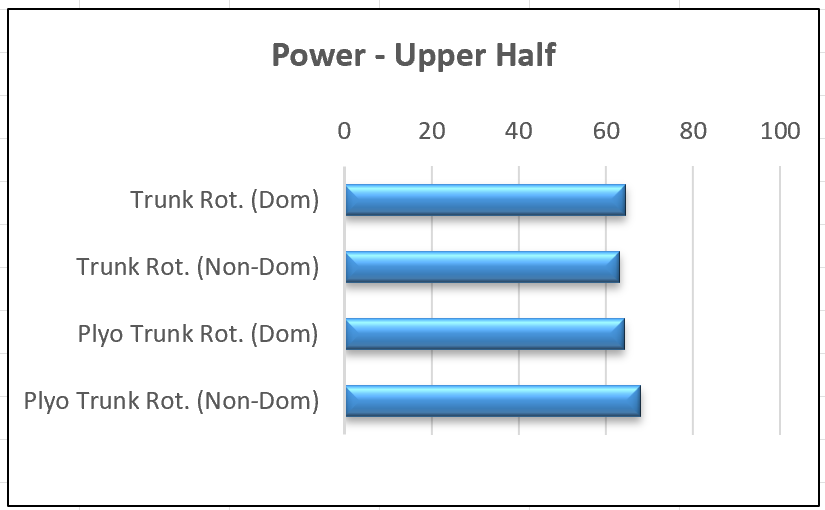
Deceleration
This test looks at the ability of the athlete’s lead leg to hit the brakes immediately at foot plant and in turn transfer force back up the kinetic chain to use during the throw, or in the case of the test, how quickly they can land on one leg and turn that force the other way with a jump. Jump height and contact time give us what is known as a “Reactive Strength Index” (RSI).
Jack scored nearly in the 100th percentile which showcased his exceptional ability to create maximum power output quickly unilaterally (on one leg) in our S. leg drop jump test. While both the CMJ and the S. Leg Drop Jump tell us a lot, the latter is a much more sports-specific test for baseball players.

2. Pitching Mechanics
The pitching mechanics analysis involves analysis of dozens of possible disconnects in the delivery which are then summarized into a summary report. In Jack’s case we also had the benefit of our in-house motion capture report. The following is a summary of the summary.
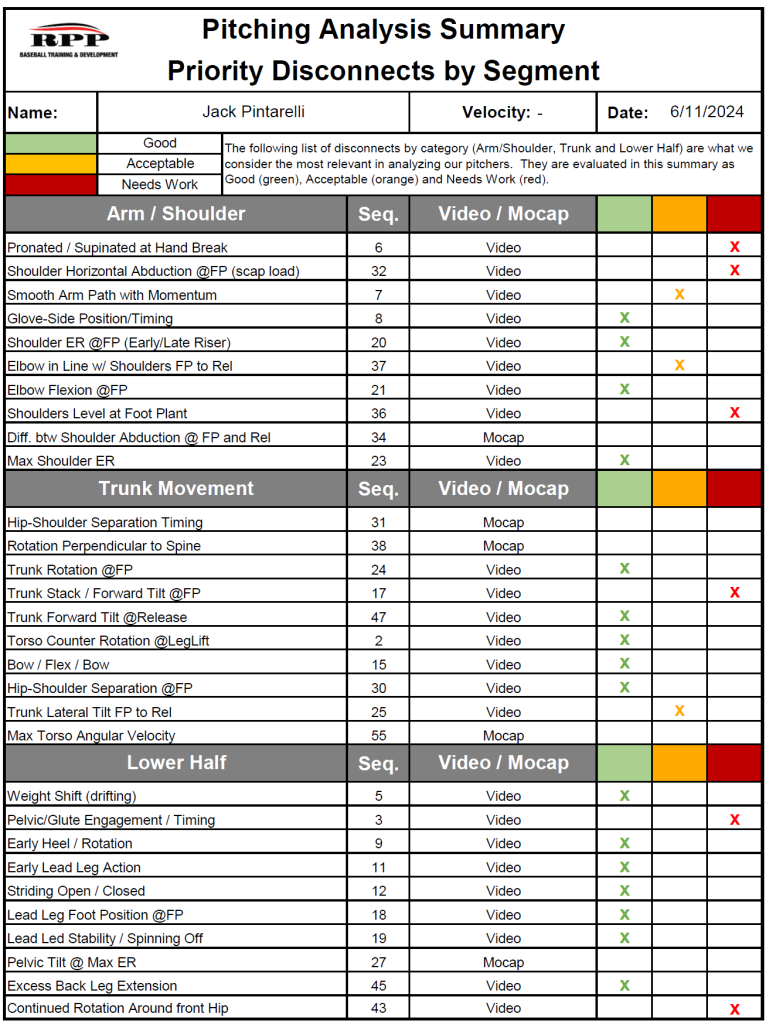
It’s important to prioritize when addressing too many mechanical issues at a time. We identified a number of disconnects when analyzing Jacks delivery (see above). We then chose what we believed to be the 4 biggest disconnects we needed to address. Below is a summary and description of each:
Arm/Shoulder
-
- Shoulder Horizontal Abduction @FP (scap load): Shoulder Horizontal Abduction at Ball Release is an athlete’s ability to get their arm up on time through release. Not accessing the scap puts a ton of pressure on the humeral head and creates a pushy arm action which could be caused by the upper-half mobility restrictions found on the table portion of the assessment.
Trunk Movement
-
- Trunk Stack/Forward Tilt at Foot Plant: This is the ability to keep the pelvis and upper body stacked from the beginning of the linear move all the way into FP. A stable and braced trunk allows a pitcher to store energy longer before he rotates violently into release.
Lower Half
-
- Pelvic/Glute Engagement: We categorize this by inefficient weight distribution on the back leg/foot with a hinge at the hips. Maintaining a stacked trunk going into FP to avoid getting into extension and jumping out of the backside is key to delivering a higher velocity strike.
- Continued Rotation Around the Front Hip: Effectively rotating into the front hip accepting force displays efficient deceleration patterns that take a lot of stress out of the arm to avoid “slamming” the posterior shoulder after ball release. Ineffective rotation into the front hip could potentially lead to excessive elbow extension and stressing both elbow and shoulder.
Addressing mechanical disconnects is often addressed by work both in the weight room and specific drill sets we assign the athlete to be performed on a daily basis.
A lot of Jack’s work was to focus on cleaning up his arm action and upper half mechanics due to his tight upper half mobility. In addition to his mobility correctives, the following plyo drills were assigned to help with movement down the mound:
-
- Toss-in Drill – We use this to take time and tension out of the throw, creating a looser arm action. Allowing the arm to react from catching the ball on the way down helps with creating a cleaner arm spiral.
-
- Figure 8 Rocker -Used to help athletes feel a more relaxed arm and shoulder to eliminate muscling up the arm path. This helps create better momentum and a more whip-like arm action.
-
- Step Back Drill – Used to improve shifting COM and reinforce positive glute engagement.
-
- Step Behind w/ Leg Lift – Used to drive a linear move down the mound. Reinforces tension in the back hip while maintaining arm fluidity from the previous 2 drills.
3. Pitching Arsenal
Jack came in with a 4SFB, SNK, CH, SL. His SL was by far his best pitch, and we needed the rest of his arsenal to complement it. His least used pitch was his SNK, and it was due to his confidence in his ability to throw it when and where he wanted, he also relied heavily on his 4SFB. Being that Jack is a lower arm angle guy; it was important for us to develop the consistency and effectiveness of his SNK as well as his CH.
The one pitch that we added to his arsenal that we used to expand the zone and change levels was his Curveball. We wanted to add this to compliment the slider because he does show the ability to supinate well even though he is a low-slot pronator. We added a spike to his grip to allow for it to create depth with a greater movement profile. The CH became a weapon when we provided him with a seam-shifted grip that he was able to ride comfortably on the zero IVB line with 12+ HB.
Jack now has a 5-pitch arsenal that offers two types of fastballs and two types of breaking balls with a devastating changeup so he can be on the attack on the mound.
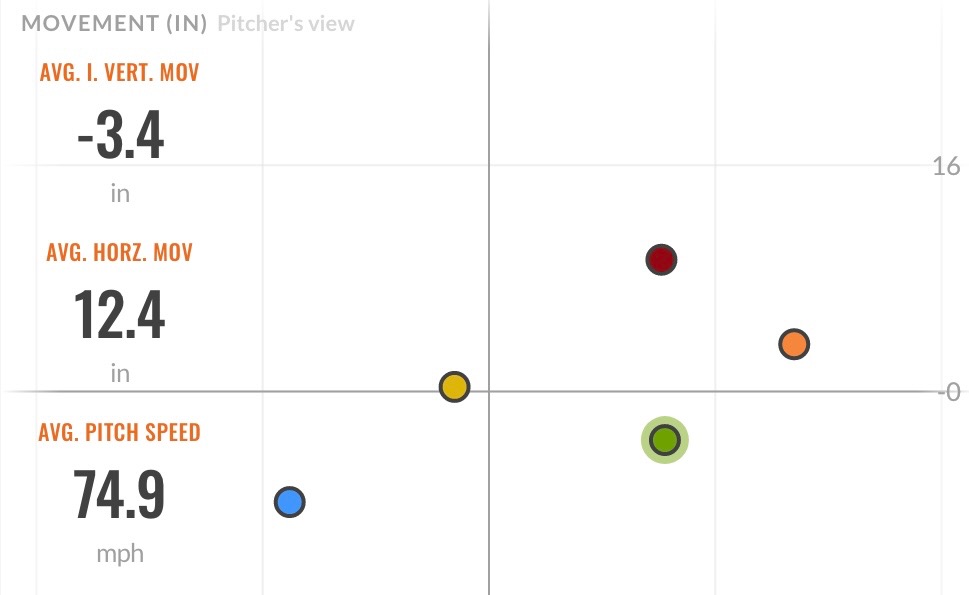
4. Summary
As highlighted earlier, Jack has added 5-6 mph to his FB and T86 since the prior year. Given the significant increase in lean muscle mass, it’s apparent that there is a lot more in the tank here. This past spring, with 37.2 innings under his belt, Jack struck out 39 hitters and pitched to an ERA of 1.86.
In addition, he now has a 5-pitch arsenal that offers two types of fastballs and two types of breaking balls with a devastating changeup so he can be on the attack on the mound.
As a member of RPP Recruiting, he is receiving some strong college interest, and we look forward to seeing his commitment in the coming months.
Well done, keep up the hard work, Jack!
By Niko Leontarakis (Director of Pitching)
You live too far to train with us in-house at RPP? You can now train with us on a REMOTE basis.


